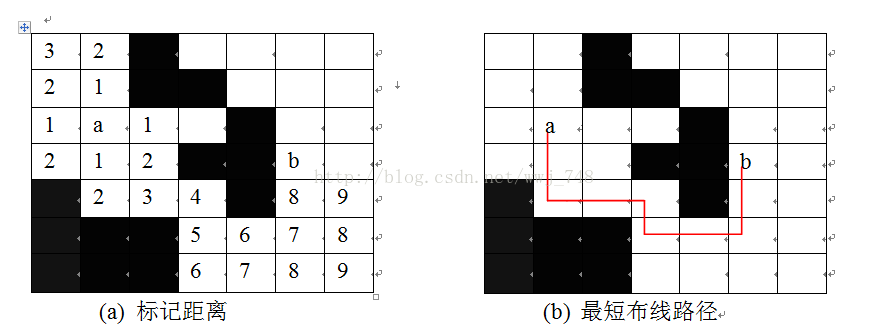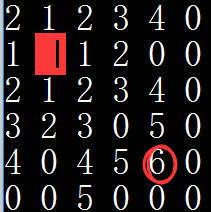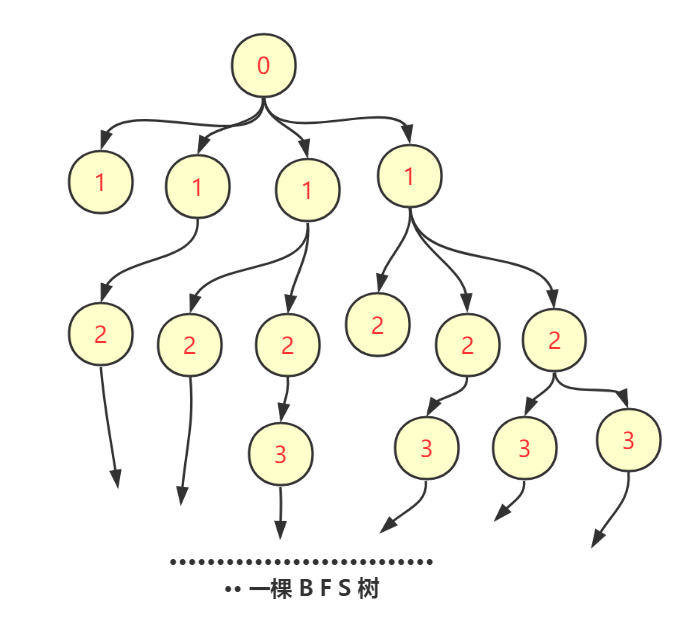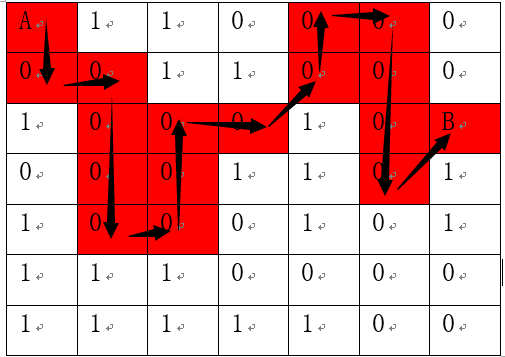C++ 电路布线/最短路径问题
问题描述

用二维数组表示地图,若值为 1 则表示有障碍物,若值为 0 则表示可以通行。
输入: m*n 的二维数组,布线起点坐标,布线终点坐标。
输出: 最短布线距离以及对应的布线路径。
问题分析
从起点开始布线,将起点标记为 0 ,把四周可布线的位置标记为 起点标记值 + 1 ,同时将这些点插进队列 Q (插到队尾)。
从 Q 中取出一个点(队首元素)重复布线动作,将可布线位置标记为 取出点标记值 + 1 ,并插进 Q 。不断重复上一个动作,直到找到终点,此时终点的标记值即最短布线距离。
为什么终点的标记值会等于最短布线距离呢?
事实上对于每一点这个结论都是成立的(某点的标记值=该点到起点的最短距离)。

(方块表示起点,椭圆表示终点)
在布线的过程中,始终遵循的规则是:标记值越小的越先布线。(越先入队的越先布线)
我们假设对于标记值为 n 的点该结论成立,我们只需要证明从标记值为 n 的点出发,找到的标记值为 n+1 的点确实最短就可以了。
我们考察标记值 n 周围的可布线点,可以分为两类:已布线点和未布线点。
对于未布线的点:由布线规则可知,所有标记值 < n 点都已经布线完毕,点未被布线的唯一原因是任何一个标记值 < n 的点都无法与它相邻(到不了或者需要付出更大的代价才能到),所以该点只能通过点 n 或者相邻的标记值同样为 n 的点与起点联通,从而取得最小值,故对标记值为 n+1 的点结论同样成立。
因此该结论对于任意标记值的点都成立。
或者,一句话说就是迷宫格子形成了一颗BFS树,事实上我们已经把所有更短的路径都search出来了。所以不可能有更短的。

C++ 代码
#include <stdio.h> #include <cstdlib> #include <iostream> #include <queue> using namespace std; #define MAX 6 struct Point { int x; int y; int len; Point* pre; Point(): len(0), pre(0) {} Point(int x, int y): x(x), y(y), len(0), pre(0) {} void setPoint(int x, int y) { this->x = x; this->y = y; } }; queue<Point> mark; void test(Point (*p)[MAX]); bool work(Point& q, Point& e, int (*map)[MAX], Point (*p)[MAX]) { int x, y; // up if ((x=q.x-1) >= 0 && map[x][y=q.y] != 1 && p[x][y].len == 0) { p[x][y].len = q.len + 1; p[x][y].pre = &q; if (x == e.x && y == e.y) { return true; } else { mark.push(p[x][y]); } } // down if ((x=q.x+1) < MAX && map[x][y=q.y] != 1 && p[x][y].len == 0) { p[x][y].len = q.len + 1; p[x][y].pre = &q; if (x == e.x && y == e.y) { return true; } else { mark.push(p[x][y]); } } // left if ((y=q.y-1) >= 0 && map[x=q.x][y] != 1 && p[x][y].len == 0) { p[x][y].len = q.len + 1; p[x][y].pre = &q; if (x == e.x && y == e.y) { return true; } else { mark.push(p[x][y]); } } // right if ((y=q.y+1) < MAX && map[x=q.x][y] != 1 && p[x][y].len == 0) { p[x][y].len = q.len + 1; p[x][y].pre = &q; if (x == e.x && y == e.y) { return true; } else { mark.push(p[x][y]); } } return false; } void f(int (*map)[MAX], Point& s, Point& e, bool& k, Point (*p)[MAX]) { mark.push(s); int flag = false; while (mark.size() != 0 && !flag) { // 终止条件:找遍所有点都没找到终点&找到终点 flag = work(mark.front(), e, map, p); mark.pop(); test(p); // 输出布线情况 } k = flag; } void test(Point (*p)[MAX]) { // 输出布线情况 for (int i = 0; i != MAX; ++i) { for (int j = 0; j != MAX; ++j) { printf("%d ", p[i][j].len); } cout << endl; } cout << endl; } void printPath(Point& end) { if (end.pre == 0) { printf("[%d][%d]\n", end.x, end.y); return; } else { printPath(*(end.pre)); printf("[%d][%d]\n", end.x, end.y); } } int main() { int map[MAX][MAX] = { 0, 0, 0, 0, 0, 1, 0, 0, 0, 0, 1, 0, 0, 0, 0, 0, 0, 1, 0, 0, 0, 1, 0, 1, 0, 1, 0, 0, 0, 0, 1, 1, 0, 1, 1, 1 }; Point s(1, 1); Point e(4, 4); bool k = false; Point p[MAX][MAX]; p[s.x][s.y].len = 1; for (int i = 0; i != MAX; ++i) { for (int j = 0; j != MAX; ++j) { p[i][j].setPoint(i, j); } } // 初始化 f(map, s, e, k, p); if (k) { printf("MIN=%d\n", p[e.x][e.y].len); printPath(p[e.x][e.y]); } else { printf("ERROR\n"); // 起点与终点不连通 } return 0; }
附件:迷宫问题

上面那道题用队列,这道用栈。
#include <stdio.h> #define MAX 7 struct Point { int x; int y; bool mark; Point(): x(0), y(0), mark(false) {} Point(int x, int y): x(x), y(y) {} void setPosition(int x, int y) { this->x = x; this->y = y; } }; Point p[MAX][MAX]; bool seekPath(int (*map)[MAX], Point& s, Point& e) { p[s.x][s.y].mark = true; if (s.x == e.x && s.y == e.y) { printf("MAP[%d][%d]\n", e.x, e.y); return true; } //printf("seekPath:1\n"); if (s.x+1 < MAX && map[s.x+1][s.y] != 1 && !p[s.x+1][s.y].mark && seekPath(map, p[s.x+1][s.y], e)) { printf("MAP[%d][%d]\n", s.x, s.y); return true; } //printf("seekPath:2\n"); if (s.x-1 >= 0 && map[s.x-1][s.y] != 1 && !p[s.x-1][s.y].mark && seekPath(map, p[s.x-1][s.y], e)) { printf("MAP[%d][%d]\n", s.x, s.y); return true; } //printf("seekPath:3\n"); if (s.y+1 < MAX && map[s.x][s.y+1] != 1 && !p[s.x][s.y+1].mark && seekPath(map, p[s.x][s.y+1], e)) { printf("MAP[%d][%d]\n", s.x, s.y); return true; } //printf("seekPath:4\n"); if (s.y-1 >= 0 && map[s.x][s.y-1] != 1 && !p[s.x][s.y-1].mark && seekPath(map, p[s.x][s.y-1], e)) { printf("MAP[%d][%d]\n", s.x, s.y); return true; } //printf("seekPath:5\n"); if (s.x+1 < MAX && s.y+1 < MAX && map[s.x+1][s.y+1] != 1 && !p[s.x+1][s.y+1].mark && seekPath(map, p[s.x+1][s.y+1], e)) { printf("MAP[%d][%d]\n", s.x, s.y); return true; } //printf("seekPath:6\n"); if (s.x+1 < MAX && s.y-1 >= 0 && map[s.x+1][s.y-1] != 1 && !p[s.x+1][s.y-1].mark && seekPath(map, p[s.x+1][s.y-1], e)) { printf("MAP[%d][%d]\n", s.x, s.y); return true; } //printf("seekPath:7\n"); if (s.x-1 >= 0 && s.y+1 < MAX && map[s.x-1][s.y+1] != 1 && !p[s.x-1][s.y+1].mark && seekPath(map, p[s.x-1][s.y+1], e)) { printf("MAP[%d][%d]\n", s.x, s.y); return true; } //printf("seekPath:8\n"); if (s.x-1 >= 0 && s.y-1 >= 0 && map[s.x-1][s.y-1] != 1 && !p[s.x-1][s.y-1].mark && seekPath(map, p[s.x-1][s.y-1], e)) { printf("MAP[%d][%d]\n", s.x, s.y); return true; } return false; } void f(int (*map)[MAX], Point& s, Point& e) { // chushihua for (int i = 0; i != MAX; ++i) { for (int j = 0; j != MAX; ++j) { p[i][j].setPosition(i, j); } } // work if (!seekPath(map, s, e)) { printf("ERROR!\n"); } //printf("f:runnable\n"); } int main() { int map[MAX][MAX] = { 0, 1, 1, 0, 0, 0, 0, 0, 0, 1, 1, 0, 0, 0, 1, 0, 0, 0, 1, 0, 0, 0, 0, 0, 1, 1, 0, 1, 1, 0, 0, 0, 1, 0, 1, 1, 1, 1, 0, 0, 0, 0, 1, 1, 1, 1, 1, 0, 0 }; Point s(0, 0); Point e(2, 6); f(map, s, e); //printf("main:runnable\n"); return 0; }
留着备用。

 浙公网安备 33010602011771号
浙公网安备 33010602011771号